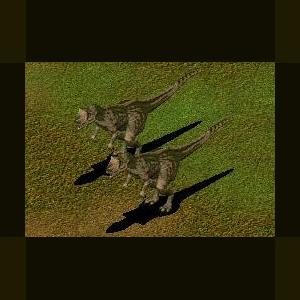About This File
Carcharodontosaurus was a gigantic carnivorous carcharodontosaurid dinosaur that lived around 98 to 93 million years ago, during the Cretaceous Period.
It was nearly as long as Tyrannosaurus, growing to an estimated 11.1-13.5 meters (36-44 feet) and weighing up to 2.9 metric tons. The name Carcharodontosaurus means 'shark lizard', after the shark genus Carcharodon (from the Greek karcharo meaning 'jagged' and odonto meaning 'teeth') and sauros, meaning 'lizard'
Carcharodontosaurus was a carnivore, with enormous jaws and long, serrated teeth up to eight inches long. Paleontologists once thought that Carcharodontosaurus had the longest skull of any of the theropod dinosaurs. However, the premaxilla and quadrate bones were missing from the original African skull, which led to misinterpretion of its actual size by researchers. A more modest length of 1.6 meters (5.2 ft) has now been proposed for C. saharicus, and the skull of C. iguidensis is reported to have been slightly larger at 1.75 m in length (5.5 ft). Still, the honor of the largest theropod skull now belongs to another huge carcharodontosaurid dinosaur, the closely related Giganotosaurus (with skull length estimates up to 1.95 m) (6.3 ft).
The Endocranial cast, of the impression of the brain on the inside of the skull, and inner ear anatomy of Carcharodontosaurus saharicus resembled modern Crocodylia.The size of the cerebrum relative to the total brain was similar to modern reptiles, but small relative to coelurosaurian theropods and birds.
Carcharodontosaurus fossils were first found by Charles Depéret and J. Savornin in North Africa in 1927. Originally called Megalosaurus' saharicus(many theropods were once erroneously referred to as Megalosaurus), its name was changed in 1931 by Ernst Stromer von Reichenbach to that used today. Stromer named Carcharodontosaurus "for its mainly Carcharodon-like teeth", which were "not recurved, almost bilaterally symmetrical but with convex edges." These first fossils of Carcharodontosaurus were destroyed during World War II. However, cranial material from a Carcharodontosaurus was again discovered in Morocco in 1996 by paleontologist Paul Sereno. Stephen Brusatte and Paul Sereno reported a second species of Carcharodontosaurus, differing from C. saharicus in some aspects of the maxilla and braincase. This second species, which was discovered in Niger in 1997, was named C. iguidensis in December of 2007.



Recommended Comments
Create an account or sign in to comment
You need to be a member in order to leave a comment
Create an account
Sign up for a new account in our community. It's easy!
Register a new accountSign in
Already have an account? Sign in here.
Sign In Now